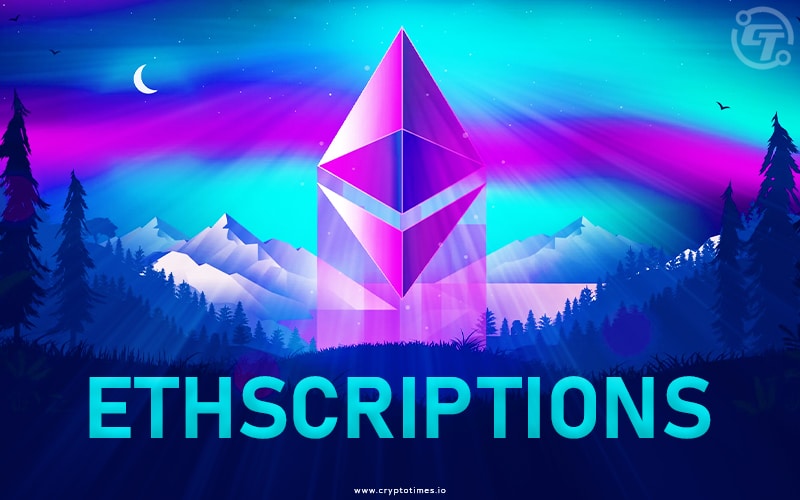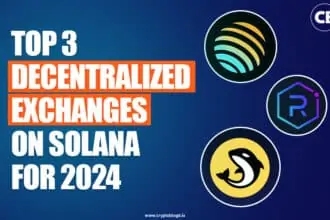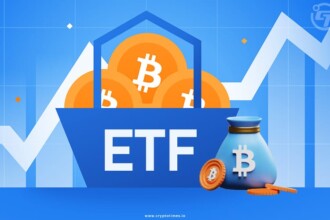Digital artifacts and the concept of NFTs left an immersive impression on the crypto users’ minds. While the crypto space has been juggling to prove its potential, NFTs made their way through users’ hearts.
Various appealing and promising NFT projects such as BAYC (Bored Ape Yacht Club), Cryptopunks, and others generated millions of dollars in trades. To enhance the space of digital artifacts, a new concept called Ethscription has arrived on the Ethereum network that could prove to be a game changer in the digital collectible space.
Ethscription is inspired by the Bitcoin Ordinals concept, which allows users to create compressed digital artifacts by inscribing data into Satoshi. While having almost the same applications as NFTs, Ethscriptions have a lot of additional functionality and advantages that can give them an edge over the former. In this article, we will understand the mechanism behind Ethscriptions and discuss their potential future.
So, without further ado, let’s get started.
What are Ethscriptions?
Ethscriptions, or Ethereum inscriptions, are a new way of creating and sharing digital artifacts on Ethereum using transaction calldata. Calldata refers to the data that is passed along with an Ethereum transaction. When you send a transaction on the Ethereum blockchain, you can include additional information or parameters within the transaction’s data field. This data can be used to specify the details of the transaction or provide input for smart contracts.
The Ethscriptions protocol went live on June 17 2023, by Tom Lehman, a co-founder of the Capsule 21 podcast and former CEO of genius.com. Ethscriptions’ creator touted it as an answer to Bitcoin’s similar development “Ordinals Inscriptions”. Here note that Ethscription only supports images. However, the creators of Ethscriptions have expressed their intention to incorporate various types of files in the future.
Ethscriptions represent a fascinating development within the Ethereum ecosystem. They enable the creation and sharing of digital artifacts using the Ethereum blockchain, ensuring uniqueness and leveraging successful transactions. With the launch of ethscriptions.com, the exploration and creation of Ethereum inscriptions are made more accessible to enthusiasts and users interested in participating in this new form of digital expression.
How Do Ethscriptions Work?
Ethscriptions works by using the Ethereum blockchain to store the ownership information for each digital artifact.
- One can create the inscriptions by making successful transactions on the Ethereum network that include distinct data uniform resource identifiers (URIs).
- To ensure the utmost uniqueness, each URI is carefully crafted to ensure that its content remains distinct. This ingenious approach guarantees that no other Ethscription shares identical information.
- When someone creates an Ethscription, they are considered the creator of that Ethscription. The person who receives the transaction is called the initial owner.
Recently, Lehman has launched a website called ethscriptions.com, where people can explore and browse all the Ethscriptions created so far. The website also provides tools for creating Ethscriptions on the Ethereum blockchain.
Furthermore, the owner can also transfer their Ethscription to others. To transfer an Ethscription, you need to include its unique identifier, called a hash, in a transaction. When this transaction is processed, the person sending the transaction becomes the new owner of the Ethscription. However, it’s important to note that the file used for an Ethscription must not be larger than 96 kilobytes.
How are Ethscriptions Different From NFTs?
Ethscriptions is a new method that allows for adding any kind of information directly to the Ethereum network. Ethscriptions leverage a feature called “calldata,” which is the data stored within a smart contract on Ethereum. This enables a more affordable and decentralized way to create and distribute these assets than traditional methods like NFTs that rely on smart contracts.
In contrast, when people create non-fungible tokens (NFTs), they link their file to the block. This process provides proof of ownership and origin, making the NFT valuable. The metadata of the NFT is connected to an external source that stores the actual file. On the other hand, Ethscriptions are created using calldata and store all the information directly on the Ethereum network itself.
Ethscriptions is different from NFTs in a way that it does not hold any smart contract logic, which makes them less composable than traditional NFTs. Though, this storage mechanism of Ethscription might become their biggest hurdle in future developments.
Step-by-Step Guide To Create Ethscriptions
You can create Ethscriptions on its official website by following these simple steps.
- Convert your image/ digital file (max size: ~90KB) to a Base 64-encoded data URI using a service like base64-image.de. Images are recommended for optimal functionality.
- Use an online tool like Hexhero to convert the data URI to hex format.
- Send a 0 ETH transaction to the desired recipient of the Ethscription, including the hex data from step 2 in the “Hex data” field.
- Give it a few moments, and your Ethscription should appear on the designated page unless the same data has already been Ethscribed. Here, note that the duplicate content should not be considered.
Difference Between Ethscriptions and Ordinals Inscriptions
One notable difference between Ethscriptions and Bitcoin Ordinals Inscriptions lies in their respective platforms. Ethscriptions operate on the Ethereum network, while Bitcoin Ordinals function within the Bitcoin ecosystem. This platform distinction influences various aspects of their functionality and features.
Where Bitcoin Ordinals stores smart contract transaction data on the Bitcoin network, Ethscriptions leverages the calldata function to create inscriptions, and hence they are more affordable for artists and creators than control storage. Furthermore, Ethscriptions are intended to reduce gas fees (transaction costs) which is a big trouble in the case of Bitcoin Ordinals.
Furthermore, there are some practical differences in how the two protocols work. Ethscriptions require each image to be unique, which means that no two Ethscriptions can be the same. On the other hand, Ordinals allow identical images to be used on different coins.
On the flip side, Ethscription supports a smaller size of data as it’s limited to below 96 kilobytes, which is less than Bitcoin Ordinals, which allow creators to form inscriptions with up to 4 megabytes.
In the end, while Ordinals supports all types of digital files like text, video, music, or games, Ethscription can only images. However, in the future, it plans to eventually add different file types.
However, if we put their competition aside for a while, then inscription models on Ethereum and Bitcoin Ordinals are likely to bring fresh trends in the NFT space.
Advantages of Ethscription
There are numerous advantages of Ethscription in the conventional world that NFTs cannot offer.
1. User-Friendly Interface
- Intuitive platform for users of all levels of familiarity with blockchain technology.
- Easy navigation and utilization for creating and selling digital assets
- Suitable for newcomers to the world of NFTs.
- Simplified processes for a seamless user experience.
- Clear instructions and guidance were provided.
2. Uncompromising Security
- Robust security features of the Ethereum blockchain.
- Each NFT is stored on a decentralized network.
- Guarantees uniqueness and prevents counterfeiting or tampering.
3. Transparency at its Core
- Leverages the Ethereum blockchain for transparency in transactions.
- The ownership history of each NFT can be traced.
- Provides a clear and immutable record of the NFT’s journey.
4. Accessibility for All
- Highly accessible platform open to anyone with an internet connection.
- No extensive technical expertise is required.
- Welcomes artists, collectors, and enthusiasts to explore and engage in the world of NFTs.
Note here that, although inscriptions on prominent blockchain networks are expected to boost the NFT space, it is feasible to choose the right NFT marketplace if you wish to get one. Currently, Ethscriptions is only supported by selected platforms as it is still new to the industry. Currently, it is supported by the most popular NFT marketplaces, OpenSea and the other one is Emblem Vault.
What will the Ethscription future look like?
The future of Ethscriptions may bring further innovation and advancements within the Ethereum ecosystem. As the popularity of NFTs continues to grow, Ethscriptions will evolve to meet the changing needs and demands of users. Here is a glimpse of what the future of Ethscriptions may look like:
- Enhanced Features and Functionality
Ethscriptions will likely introduce new features and expanded functionality to provide a more immersive and engaging experience for creators and users. This may include support for additional file types, such as 3D models, augmented reality (AR) assets, and virtual reality (VR) experiences, opening up a world of possibilities for digital expression.
- Community-driven Development
Ethscriptions may foster a vibrant community of creators, collectors, and enthusiasts who actively contribute to the development and improvement of the platform. This will also make the Ethereum ecosystem more collaborative. This collaborative approach could lead to the emergence of innovative tools, templates, and resources that streamline the creation and distribution of Ethscriptions, fostering a thriving ecosystem.
- Scalability and Interoperability
As the Ethereum network continues to evolve and scale, Ethscriptions will benefit from improved scalability solutions. These advancements will enable Ethscriptions to handle a larger volume of transactions and provide a seamless user experience while maintaining the security and integrity of the platform.
- Integration of Smart Contract Automation
Ethscriptions may incorporate smart contract automation features, simplifying the process of creating, selling, and transferring NFTs. Automated smart contracts can streamline the execution of transactions, reduce costs, and provide enhanced security and transparency, making Ethscriptions more efficient and user-friendly.
- Expanded Marketplace and Ecosystem
Ethscriptions will likely see the growth of a robust marketplace and ecosystem around the platform. This includes dedicated platforms for buying, selling, and trading Ethscriptions and collaborations with other NFT marketplaces and platforms to increase exposure and accessibility for creators and collectors.
Conclusion:
NFTs (Non-Fungible Tokens) are tokens that can be used to represent ownership of unique items such as art, collectibles, and even real estate. A lot of people see NFT as an investment opportunity. For example, we have witnessed enormous cash flow in the NFT space and a rush for top-notch NFT collections like Bored Ape Yacht Club, Crypto Punks, and so on.
With the increasing hype of NFTs, there was a debut of NFTs on Bitcoin with Ordinals Inscription, which inspired the call for Ethscription. Ethscriptions just debuted on the Etherecosystem, and its potential is still hidden. Though, after observing the whopping demand for digital collectibles and artifacts in the form of NFTs, we can say that Ethscription could have an appealing future. It will empower the Ethereum blockchain network with more functionality while creating an interactive space at the same time.
Furthermore, Ethscriptions can give tough competition to the inscription model on the Bitcoin network through Ordinals. No wonder, in the forthcoming weeks, we are going to see a hike in the demand for digital artifacts in the form of Ethscriptions.







